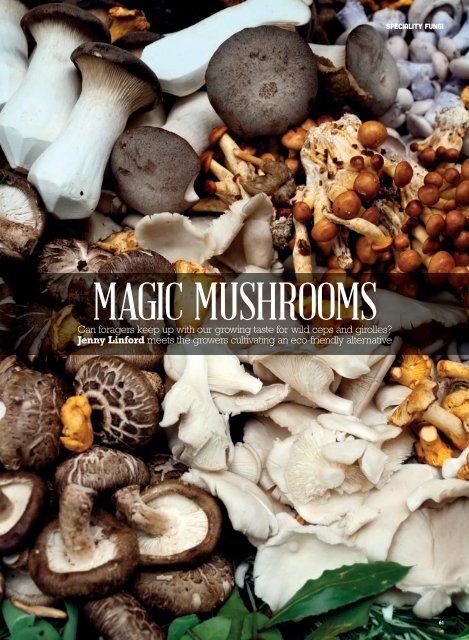MAGIC MUSHROOMS
Click here for PDF - Jenny Linford
Click here for PDF - Jenny Linford
- No tags were found...
Create successful ePaper yourself
Turn your PDF publications into a flip-book with our unique Google optimized e-Paper software.
SPECIALITY FUNGI<strong>MAGIC</strong> <strong>MUSHROOMS</strong>Can foragers keep up with our growing taste for wild ceps and girolles?Jenny Linford meets the growers cultivating an eco-friendly alternative61
SPECIALITY FUNGIAs a nation, we Brits have traditionally beenrather wary of mushrooms, unlike say theFrench, Italian and Polish, sticking to familiarspecies such as button and field. In the 1980showever, with a little encouragement fromchefs such as Antonio Carluccio, we started totake a culinary interest in wild mushrooms like cepsand girolles. Now, a generation of mushroom growersare making the case for using cultivated specialitymushrooms, rather than gathered wild fungi.Jane Dick set up Fundamentally Fungus in 1998 tochampion and provide cultivated mushrooms. “Our aimin life is to wean chefs off wild mushrooms ontocultivated speciality mushrooms,” she declaresstraightforwardly. For Jane, who has a degree inmicrobiology, concerns over the damage caused to theenvironment by uncontrolled wild mushroomharvesting are an important motivating factor.“Look what fungi have given mankind in terms offood and medicine – cheese, bread, antibiotics,” shepoints out. “In the UK we only have 4% of ourwoodlands left and just a tiny fraction of that is ancientwoodland which is where mushrooms grow. We need tobe very careful about losing resources we haven’tdocumented yet.”Working with other specialist mushroom growers,Fundamentally Fungus offers a range of cultivatedmushrooms, from small, brown nameko to eryngi, theking oyster mushroom. “It’s possible to grow 16different types, though morelles, chanterelles, ceps andtruffles can’t be cultivated because they’re mycorrhizal,which means they need the tree roots to grow.”Not surprisingly, Jane herself thoroughly enjoyseating her cultivated mushrooms. “The best ones arefantastically flavoursome,” she enthuses, “One is hen ofthe woods, fabulously savoury. The other one, a newvariety we call abalone because of its shape, has thetexture of a puffball. Cut it thinly and fry it and it goesa beautiful brown colour and has a savouriness akin tobacon.”Improving the quality of speciality cultivatedmushrooms has been part of Fundamentally Fungus’aim. “Cultivated speciality mushrooms were seen assecond best, because they were poor quality. We’rewell-regarded because we’re about quality; you need ahigh-quality product to get the attention of chefs.“Freshness is key – mushrooms have aromas, whichare lost when they’re not fresh. We’re finding that theyounger chefs, who haven’t been French-trained in theway senior chefs were, are more open-minded aboutusing cultivated speciality mushrooms. They want goodingredients and they want something new.”Soil to StardomCultivating speciality mushrooms, all the growersagree, is far from easy and there is much learning stillto be done. The wonderfully-named HumungousFungus, set up in 1995 by Joy and Richard Edwardsof Red Pig Farm, a holding in the Brecon Beacons,Wales has always had, as part of its vision, the sharingand spreading of the knowledge of mushroomcultivation.Having become fascinated by mushroom growing,the Edwards created their own version of containermushroom growing using shipping containers ratherthan the more conventional polytunnels or sheds beingused in the States. “People use the resourcesavailable,” explains Joy, “and in the UK we’ve got lotsof ports and so lots of shipping containers whichneeded further use. It was a relatively cheap way forpeople to set up mushroom-growing systems.”Such is their expertise, that Humungous Funguswere brought in a few years ago by acclaimed chefRaymond Blanc to set up a mushroom valley in thebeautiful grounds of Le Manoir aux Quat’ Saison inOxfordshire. “The idea is to grow the mushrooms forthe kitchen at Le Manoir, to be able to supply themfresh and of high quality, which is what the garden isused for. They’re growing shiitake, king oyster andwe’ve got beds outside where we’ve put in blewit andoyster mushrooms. They have got a shipping containerin the garden there, but it’s very well-hidden!”In addition to spreading mushroom growingknowledge, the Edwards supply mushroom spawn andmushroom blocks and also turn mushrooms into a foodsupplement. “We live right on top of a mountain andit's not easy to get the mushrooms to market,” explainsJo, “so we thought we’d make a supplement. The62
eauty of it is that the preparation of it is very simple.Lots of people want the extract; people rely on us tomake it for them.”Among the mushroom growers inspired byHumungous Fungus is Gary Whiteley, who ten yearsago moved from Luton to Wales to set up MaesyffinMushrooms using containers in which to cultivate bothshiitake and the dramatic-looking Lion’s Mane. “Evenafter ten years’ experience, it’s still hard growingmushrooms! There are too many variables – theweather, the type of wood, the age of the wood. It’s alot of work; a seven day a week job. You have to behere to pick; you’ve got to keep the cycle going. I’m aslave to my mushrooms!”Gary supplies his mushrooms to local shops andrestaurants. “I’m in a sparsely populated area butwe’ve got a good food culture here. The restaurantsare using local produce, and they use my mushroomsin soups, on toast, for flavour. Local is what I’m aimingfor.”Fungi FlavourCynan Jones of The Mushroom Garden, in Snowdonia,Wales, who has been growing shiitake since 2007, isanother grower following the container modelpioneered by the Humungous Fungus project. “Thebiggest challenge is that you need two differentenvironments,” he explains. “Most wild mushroomsappear when the season changes, because they thinkwinter is coming and that they’re going to die. Onecontainer mimics the summer which is very warm,then we move them into the second cooler containerwhich shocks them into fruiting. It’s still exciting to seethem pop up!”Cynan has found a receptive audience among localchefs for his mushrooms. “Provenance, where theycome from, is very important. Grown in Welsh oak,using Welsh air and Welsh dampness! I grow 100kg aweek and I can be very bespoke. One of the chefs wedeal with gets 1kg large open shiitake mushrooms and1kg small ones; we can pick what he wants.” Inaddition to fresh shiitake, Cynan also dries hismushrooms, “giving a one year shelf life instead of aseven-day shelf life and intensifying the flavour.”Giving rein to their culinary creativity, Cynan andhis family are also creating a number of foods usingthe dried mushrooms. “We blast them into a powderand sell pots of that, which gives a great kick ofmushroom flavour to any sauce or soup. I like it best ofall sprinkled onto Welsh Cheddar cheese and justmelted, so it gives a mushroomy flavour. Our UmamiSeasoning is made from shiitake powder and edibleseaweed blended with Halen Mon salt. We’ve justreleased a Mexican seasoning – Fajita, with a big lumpof mushroom powder in it, so you get the spicy kickbut also the earthy flavour of the mushrooms.”Not content with savoury products, Cynan’sdaughter Megan also added the Umami seasoning tochocolate – “A knock out,” says Cynan proudly. “Wehave a local chocolatier making them for us, usingplain chocolate and mushroom-shaped moulds.” We’rehaving great fun!” Mushroom magic, it would seem,has cast its spell on a whole wave of food producers.Growing fungi is a lot of work, a seven day a week job. You have to be here to pick, you’vegot to keep the cycle going. I’m a slave to my mushrooms63





